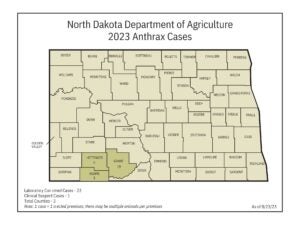There are now 16 premises affected by anthrax in southwest North Dakota. According to the North Dakota Department of Agriculture, 15 are laboratory-confirmed cases, and one is a probable case based on clinical signs.
North Dakota State University Veterinary Diagnostic Laboratory has confirmed the cases, including one case in Hettinger County and 14 Grant County.
The year’s first case popped up in a herd in Grant County in July. Producers with unusual losses on pasture and previous cases are encouraged to monitor their herds for unexplained deaths. They are also encouraged to contact local veterinarians trained to respond to anthrax.

Thankfully, effective anthrax vaccines are readily available, but immunity takes about a week to be established. Vaccines must be administered annually to be effective.
“Anthrax has been most frequently reported in northeast, southeast, and south-central North Dakota, but it has been found in almost every part of the state,” Agriculture Commissioner Doug Goehring said. “A few anthrax cases are reported in North Dakota almost every year. The animals impacted included cattle, bison, horses, sheep, llamas, and farmed deer and elk.”
The response has been a coordinated effort by multiple entities on the state and local level, including health care experts, emergency management, NDSU Extension, environmental and disposal personnel, as well as other producers and county officials.
“While typically only a few anthrax cases are reported in North Dakota every year, it can cause devastating losses in affected herds,” Goehring said. “Weather and soil conditions have contributed to the number of cases we’re seeing this year.”
Two cases of anthrax were last reported in North Dakota in 2021. In 2005, however, more than 500 confirmed deaths from anthrax were reported, with total losses estimated at more than 1,000 head.
The bacteria Bacillus anthracis cause anthrax. The bacterial spores can lie dormant in the ground for decades and become active under ideal conditions, such as heavy rainfall, flooding, and drought. Animals are exposed to the disease when they graze or consume forage or water contaminated with the spores.
In July, Minnesota also reported the first case of anthrax in decades.
»Related: 10 weird livestock diseases, syndromes, and what to look for


